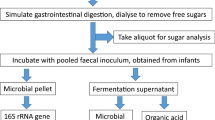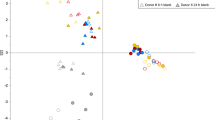Abstract
Objective: Little is known of the degree to which the colon salvages energy through starch fermentation in young children. Using a simulated colonic environment, we aimed to account for the fate of fermented raw and cooked starch in two groups of young children and in adults.
Design: A slurry was prepared from faecal samples from six infants (7–10 months), six toddlers (16–21 months) and seven adults (24–56 y). Each slurry was anaerobically incubated with raw or cooked maize starch in MacCartney bottles in a shaking water bath. Parallel incubations were stopped at 4 and 24 h. The headspace gas volume was analysed for CO2 and methane. The culture supernatant was analysed for short-chain fatty acids (SCFA), lactate and residual starch.
Results: Different patterns of fermentation were seen at 4 and 24 h. For raw starch, the production of SCFA decreased with subject age at 4 h but not at 24 h. With both substrates at 4 h, toddler stools produced significantly more CO2 than infants or adults, but there were no statistical differences at 24 h. Methane was detected in three adults only. Lactate was detected mainly at 4 h in children.
Conclusions: The results suggest that fermentation, particularly of raw starch, is a more rapid process in young children than in adults. A highly efficient energy salvage process may occur in the colon of young children.
This is a preview of subscription content, access via your institution
Access options
Subscribe to this journal
Receive 12 print issues and online access
$259.00 per year
only $21.58 per issue
Buy this article
- Purchase on Springer Link
- Instant access to full article PDF
Prices may be subject to local taxes which are calculated during checkout


Similar content being viewed by others
References
Anderson TA, Fomon SJ & Filer LJ (1972): Carbohydrate tolerance studies with 3-day old infants. J. Lab. Clin. Med. 79, 31–37.
Balmer SE & Wharton BA (1989): Diet and faecal flora in the newborn: breast milk and infant formula. Arch. Dis. Child. 64, 1672–1677.
Bond JH, Currier BE, Buchwald H & Levitt MD (1980): Colonic conservation of malabsorbed carbohydrate. Gastroenterology 78, 444–447.
Bullen CL, Tearle PV & Stuart MG (1977): The effect of “humanized” milks and supplemented breast-feeding on the faecal flora of infants. J. Med. Microbiol. 10, 403–413.
Christian MT, Edwards CA & Weaver LT (1999): Starch digestion in infancy. J. Pediatr. Gastroenterol. Nutr. 29, 116–124.
Cummings JH (1981): Short chain fatty acids in the human colon. Gut 22, 763–779.
Cummings JH, Pomare EW, Branch WJ, Naylor CPE & MacFarlane GT (1987): Short chain fatty acids in human large intestine, portal, hepatic and venous blood. Gut 28, 1221–1227.
Drasar BS (1988): The bacterial flora of the intestine. In The Role of the Gut Flora in Toxicity and Cancer, ed. IR Rowland, pp 23–38. London: Academic Press.
Edwards CA (1994): Interaction between nutrition and the intestinal microflora. Proc. Nutr. Soc. 52, 375–382.
Edwards CA, Gibson G, Champ M, Jensen B-B, Mathers JC, Nagengast F, Rumney C & Quehl A . (1996): In vitro method for quantification of the fermentation of starch by human faecal bacteria. J. Sci. Food Agric. 71, 209–217.
Edwards CA & Parrett AM (1999): Colonic fermentation—in vitro and in vivo approaches to measurement. Sci. Aliments 19, 291–300.
Edwards CA, Parrett AM, Balmer SE & Wharton BA (1994): Faecal short chain fatty acids in breast-fed and formula-fed babies. Acta Paediatr. 83, 459–462.
Edwards CA & Rowland IR (1992): Bacterial fermentation in the colon and its measurement. In Dietary Fibre—A Component of Food, eds TF Schweizer & CA Edwards, pp 119–136. London: Springer-Verlag.
Englyst HN & Cummings JH (1987): Resistant starch, a "new" food component: a classification of starch for nutritional purposes. In Cereals in a European Context, First European Conference on Food Science and Technology, ed. ID Morton, pp 221–233. Chichester UK: Ellis Horwood.
Englyst HN & Kingman SM (1990): Dietary fiber and resistant starch. A nutritional classification of plant polysaccharides. In Dietary Fiber, eds D Kritchevsky, C Bonfield & JW Anderson, pp 49–65. London: Plenum.
Fernandez F, Kennedy H, Hill M & Truelove S (1985): The effect of diet on the bacterial flora of ileostomy fluid. Microbiol. Aliment. Nutr. 3, 47–52.
Guérin-Danan C, Andrieux C, Popot F, Charpilienne A, Vaissade P, Gaudichon C, Pedone C, Bouley C & Szylit O (1997): Pattern of metabolism and composition of the faecal microflora in infants 10 to 18 months old from day care centers. J. Pediatr. Gastroenterol. Nutr. 25, 281–289.
Khin-Maung-U, Tin-Aye, Ku-Tin-Myint, Tin-Oo, Myo-Khin, Thackway SA, Connor SJ, Bolin TD & Duncombe VM (1992): In vitro hydrogen production by enteric bacteria cultured from children with small bowel bacterial overgrowth. J. Pediatr. Gastroenterol. Nutr. 14, 192–197.
Kien CL (1996): Digestion, absorption, and fermentation of carbohydrates in the newborn. Clin. Perinatol. 23, 211–228.
Kien CL, Kepner J, Grotjohn K, Ault K & McClead RE (1992): Stable isotope model for estimating colonic acetate production in premature infants. Gastroenterology 102, 1458–1466.
Kien CL, Liechty EA, Myerberg DZ & Mullet MD (1987): Dietary carbohydrate assimilation in the premature infant: evidence for a nutritionally significant bacterial ecosystem in the colon. Am. J. Clin. Nutr. 46, 456–460.
Livesey G (1990): Energy values of unavailable carbohydrate and diets: an inquiry and analysis. Am. J. Clin. Nutr. 51, 617–637.
Long SS & Swenson RM (1977): Development of anaerobic faecal flora in healthy newborn infants. J. Pediatr. 91, 298–301.
McNeil NI (1984): The contribution of the large intestine to energy supplies in man. Am. J. Clin. Nutr. 39, 338–342.
Miller TL & Wolin MJ (1979): Fermentations by saccharolytic intestinal bacteria. Am. J. Clin. Nutr. 32, 162–172.
Modler S, Kerner JA, Castillo RO, Vreman HJ & Stevenson DK (1988): Relationship between breath and total body hydrogen excretion rates in neonates. J. Pediatr. Gastroenterol. Nutr. 7, 554–558.
Moore WEC, Cato EP & Holdeman LV (1978): Some current concepts in intestinal bacteriology. Am. J. Clin. Nutr. 31, 533–542.
Parrett AM, Edwards CA & Lokerse E (1997): Colonic fermentation capacity in vitro: development during weaning in breast-fed infants is slower for complex carbohydrates than for sugars. Am. J. Clin. Nutr. 65, 927–933.
Prosser SJ, Brookes ST, Linton A & Preston T (1991): Rapid, automated analysis of 13C and 18O of CO2 in gas samples by continuous-flow, isotope ratio mass spectrometry. Biol. Mass Spectrom. 20, 724–730.
Salyers AA & Leedle JAZ (1983): Carbohydrate utilization in the human colon. In Human Intestinal Microflora in Health and Disease, ed. DJ Hentges, pp 129–146. London: Academic Press.
Scheppach W, Fabian C, Sachs M & Kasper H (1988): The effect of starch malabsorption on faecal short chain fatty acid excretion in man. Scand. J. Gastroenterol. 23, 755–759.
Shulman RJ, Wong WW, Irving CS, Nichols BL & Klein PD (1983): Utilization of dietary cereal by young infants. J. Pediatr. 103, 23–28.
Spiller GA, Chernoff MC, Hill RA, Gates JE, Nassar JJ & Shipley EA (1980): Effect of purified cellulose, pectin and a low residual diet on faecal volatile fatty acids, transit time and faecal weight in humans. Am. J. Clin. Nutr. 33, 734–739.
Stark PL & Lee A (1982): The microbial ecology of the large bowel of breast-fed and formula-fed infants during the first year of life. J. Med. Microbiol. 15, 189–199.
Weaver LT, Thomas JE, McClean P, Harding M & Coward WA (1993): Stable isotope breath tests: their use in paediatric practice. In Progress in Understanding and Management of Gastrointestinal Motility Disorders, ed. J Janssens, pp 155–168. Leuven: Department of Medicine.
Zoppi G, Andreotti F, Pajno-Ferrara F, Njai DM & Gaburro D (1972): Exocrine pancreas function in premature and full term neonates. Pediatr. Res. 6, 880–886.
Acknowledgements
Martin Christian was funded by the Nutricia Foundation.
Author information
Authors and Affiliations
Corresponding author
Rights and permissions
About this article
Cite this article
Christian, M., Edwards, C., Preston, T. et al. Starch fermentation by faecal bacteria of infants, toddlers and adults: importance for energy salvage. Eur J Clin Nutr 57, 1486–1491 (2003). https://doi.org/10.1038/sj.ejcn.1601715
Published:
Issue Date:
DOI: https://doi.org/10.1038/sj.ejcn.1601715
Keywords
This article is cited by
-
Effects of infant cereals with different carbohydrate profiles on colonic function—randomised and double-blind clinical trial in infants aged between 6 and 12 months—pilot study
European Journal of Pediatrics (2013)
-
Improving the specificity of the [13C]mixed triacylglycerol breath test by estimating carbon dioxide production from heart rate
European Journal of Clinical Nutrition (2006)
-
Rectal luminal PrCO 2, measured by automated air tonometry, does not reflect gastric luminal PrCO 2 in children
Journal of Anesthesia (2006)



